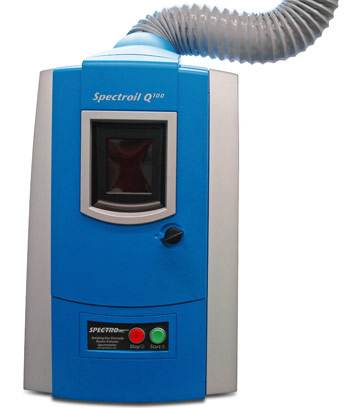
| OELCHECK test instrument: | Spectroil Q100 |
| Sample quantity: | 2 ml |
| Unit: | mg/kg (1,000 mg/kg = 1,000 ppm = 0.1% by weight) |
| Test result: | aluminium, barium, lead, boron, chromium, iron, potassium, calcium, copper, lithium, magnesium, molybdenum, sodium, nickel, phosphorus, silicon, zinc, tin Indicated if the values are over 1 mg/kg: s ilver, titanium, vanadium, tungsten |
| Analysis for: | greases and solid residues |
| Brief description: | With the AES procedure according to the Rotrode principle used by OELCHECK, the components of a lubricant sample of approx. 2 ml which adhere to a small “spark wheel” are heated in an electric arc ignited at approx. 40,000 volts to a temperature up to over 8,000 °C in less than a minute. The energy added in the form of temperature stimulates the elements and causes each element present to emit light in a characteristic wavelength. The ray of light is broken down into its spectral colours (rainbow principle) using a crystal lattice (prism principle). In a dark chamber, photocells are applied behind "outlet slots" at a radius in such a way that they can only absorb light which is characteristic for the relevant element. The change in current stimulated by the light intensity is converted into the mass of the metal present in the photocells. |
| Statement: | The AES allows up to 21 wear metals, impurities and additives to be detected. Depending on the condition of the particles, however, only components up to a size of 5 µm may be found in oil. Larger particles precipitate too quickly in oil or are not stimulated intensely enough by the arc. They are also determined in dark or black oils, irrespective of viscosity. Components of lubricants and residues can also be easily detected using this procedure. In order for this to occur, the sample must simply be applied directly onto the graphite electrode. |
| Underlying test standard: | ASTM D6595, OELCHECK test method OPM 071 |